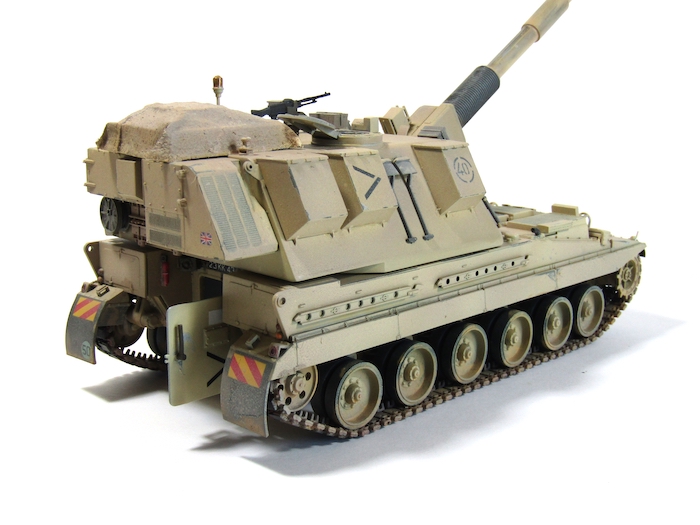
(’52 calibre ‘Braveheart’)
Full Review with Mick Stephen
Just before we get going, here’s a quick look at how it all turned out…

Introduction
The AS-90 (“Artillery System for the 1990s”), known officially as Gun Equipment 155 mm L131, is an armoured self-propelled artillery weapon used by the British Army. AS-90 was designed and built by the Armaments division of Vickers Shipbuilding and Engineering (VSEL), whose parent company became BAE Systems in 1999. VSEL provided 179 vehicles between 1992 and 1995 at a cost of £300 million ($480 million). The AS-90 was first deployed by the British Army in 1993. The AS-90s were acquired to re-equip six of the eight self-propelled field artillery regiments (each of 24 guns) in the I (BR) Corps, replacing the 105 mm FV433 Abbot SPG and older M109 155 mm Self Propelled Gun and FH70 towed howitzer.
In 1999, Marconi Electronic Systems was contracted to upgrade British Army AS-90s to include a 52 calibre gun in order to increase the range of the artillery. Part of the programme was a bi-modular charge system from Somchem of South Africa (selected after extensive trials of ammunition from many suppliers), which offered greatly reduced barrel wear. However, this ammunition failed to meet the requirement for insensitive munitions and this part of the project was terminated.
The AS90 is fitted with an auxiliary power unit to eliminate the need to run the main engine to keep the batteries charged while stationary; electrical servos drive the automated elevation, traverse, magazine, shell transfer arm and loader as well as power for electronics and communications. The vehicle is fitted with an autonomous navigation and gun laying dynamic reference unit (DRU) mounted on the trunnion. All main turret functions are controlled by a Turret Control Computer (TCC) with control and display units for the No 1 (Detachment Commander), No 2 (loader) and No 3 (layer). The combination of the DRU, TCC and powered laying controls provide auto laying. Every gun is fitted with a radar Muzzle Velocity Measuring Device. Reversionary mode laying uses deflection laying via the direct fire sight.
The gun can be brought into action fully closed down; the barrel can be clamped and unclamped from within the vehicle. In-to and out-of action times are less than 1 minute.
Specifications
- Crew: 5, on board when moving (driver plus 4 gun detachment) +5 crew in support vehicles
- Length: 9.07 m
- Width: 3.3 m
- Height: 3.0 m
- Armour: 17 mm (maximum, steel)
- Weight: 45 tons[vague]
- Calibre: 155 mm
- Range: 25 km (39 cal), 30 km (52 cal) standard charges
- Rate of fire: 3 rounds in 10 seconds (burst), 6 rounds per minute for 3 minutes (intense), 2 rounds per minute for 60 minutes (sustained)
- Secondary armament: 7.62 mm L7 GPMG
- Ammunition carried: 48 projectiles and charges (31 turret and 17 hull), 1000 MG rounds
- Main Engine: Cummins VTA903T 660 bhp 90 degree V8, 4 stroke, liquid cooled, turbo diesel
- Max Speed: 55 km/h (Road)
- Range: 370 km or 231 mi (Road)
- Ground clearance: 0.41 m; Gradient: 60°; Vertical obstacle: 0.75 m; Trench crossing: 2.8 m; Fording depth: 1.5 m
It remains in UK service and will equip three field regiments supporting armoured infantry brigades for the foreseeable future. 134 were in service in 2008, reduced to 117 in 2015. The AS-90 underwent a capability enhancement programme in 2008 and 2009, primarily relating to upgrades of the AS-90’s electronic system. (Source: Wikipedia)